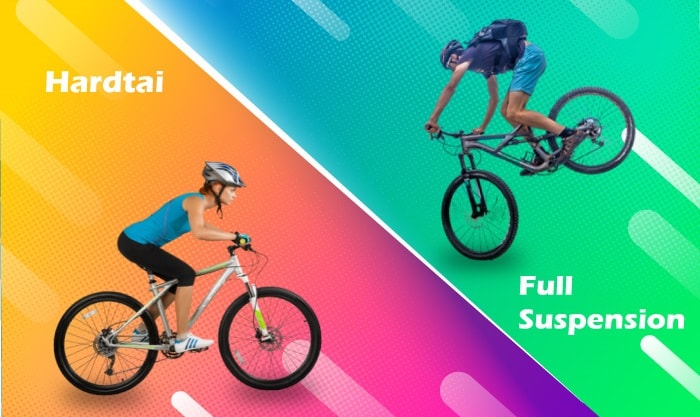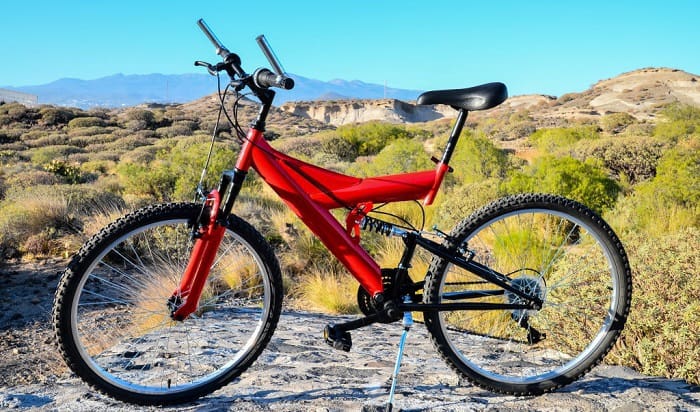Is it time to change your bike, but you have troubles choosing between a hardtail vs full suspension mountain bike? If you do, you have come to the right place.
Hardtail bikes are more affordable than full-suspension bikes but less customizable. Which type you use also affects control, traction, and comfort, so check out these factors and more below.
Table of Contents
Full Suspension MTB Vs Hardtail
Here is a table that can help you understand the main difference between hardtail and full suspension bikes.
| Hardtail |
Full Suspension |
| Increased efficiency while pedaling (less energy needed) | Less efficient but handles big jumps and drops better |
| Faster on ascents and smoother trails, slower and less grippy on rough terrains. Doesn’t absorb bumps as well, but this means more trail feedback.
|
Quicker on challenging courses with several obstacles. Enhanced stability over bumps and while descending. |
| More lightweight | Heavier (about 3.3 lb more) |
| Forces riders to learn skills they may not acquire with a full-suspension bike (like bunny hops) -> good for beginners | Allows riders to make mistakes and boosts their confidence -> doesn’t encourage beginners to refine their skills |
| Easier to maintain | More complex and technologically advanced than hardtail bikes. Requires more maintenance |
| More affordable (around a grand less than full-suspension models) | More expensive due to having more components |
| For mountain biking and other cycling activities like commuting or touring | Only for mountain biking |
| Fewer adjustments | More customizable (adjustable frame, suspension sag, etc) |
Now that we have finished tackling the pros and cons of hardtail vs full suspension bikes, it’s time to dive deeper into buying a full suspension vs hardtail.
For more info about which bike type is better for your trip, you can watch an informative video here.
How to Choose a Full-Suspension Mountain Bike
If a full-suspension bike seems favorable to you, then you should know some features that will help you obtain the best one. When I choose my bike, I always consider the size.
Having the right frame size keeps you comfortable on the road. Ensure that the bike’s reach is perfect for you, so you would not have to worry about sore arms after the trip.
Another thing that’s as important as the size is the weight. These two features go hand in hand. I had an old bike before, and I could deny how heavy it was when I tried to push it uphill. So when I chose my new bike, I went for something more lightweight.
I highly suggest choosing a bike that you can easily move and control even if you’re not riding it.
If you are a thrill-seeker like me, a full suspension bike can definitely keep up with your active lifestyle as it travels faster through tough trail sections, thanks to its rear shock. When buying a full-suspension bike, look for coil shocks if you value speed and affordability. Meanwhile, air-sprung shocks are lighter and more adjustable.
Another nice feature is rear suspension lockout, which improves energy transfer during uphill climbs.
As for the price, around $1,500 – $3,000 should give you the best full-suspension models.
How to Pick a Hardtail Mountain Bike
Hardtail bikes often have aluminum or carbon fiber frames. Aluminum is stronger, while carbon fiber is lighter. Therefore, pick the former if your bike will be subjected to rough handling.
It’s important to consider the price of the bike, as well. A price of $2000 or more will often get you a high-quality product that’s both lightweight and good for racing. A lower cost (under a grand) should suffice for regular exercises and commutes.
Although it’s possible to save money when purchasing bikes, being too frugal (buying a $300 bike, for example) might cost you more in repairs in the long run.
Another thing to consider is the length of the fork legs. These parts usually measure from 100mm to over 180mm, with higher lengths being better for rough terrains. Think of where you will ride your bike and size your stanchions accordingly.
Finally, always consider the size of the wheels. Mid-size wheels (around 27 inches) are popular choices for beginners. Overall, bike sizes differ across brands, so look for brand-specific sizing charts and consult the sellers in person.
Suspension
Bikers would often wonder why suspension is an important factor. Suspension can help us differentiate hardtail mountain bike vs full suspension and help answer the question “what is a hardtail mountain bike?”
We all know that suspension is a common feature on most mountain bicycles. Essentially, this component absorbs bumps on the roads and ensures the bike remains stable.
Hardtails only have front suspension, while full-suspension bikes have both front and rear suspension. This is why on rough terrains, riders will have to exert more effort when using a hardtail. If you’re not very athletic, which type you choose makes a huge difference.
Full-suspension mtb is the rational option for maximum performance in gravity-fed activities. I always emphasize this one because I don’t want you regretting your choice, especially if it doesn’t fit your riding style.
Conclusion
Knowing the difference between a hardtail vs full suspension mountain bike allows you to assess which type works better for your next trip.
This way, you can stay comfortable throughout the ride and never worry about finding a suitable bicycle for your trips.
You should also take note of these few things when choosing your mountain bike:
- Suspension is a great thing to consider because it gives comfort and stability all throughout the ride.
- Consider the bike’s component, weight, and climbing ability, especially if you go on trails and rough-road adventures.

“I ride my bike to work for years, but is that enough? Our carelessness towards our surroundings has taken a toll on the environment. And now, everyone is responsible for changes; even the most minor contribution is counted. With this hope and spirit, I started with my partner to establish Biketoworkday to help more individuals commute to their work sites on their bikes.”



